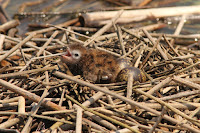BLACK TERN
BLACK TERN (Chlidonias niger) – (See images below)
DESCRIPTION: The Black Tern in breeding plumage has a mostly black head and a grey body except the vent area, which is white. Wings are narrow, pointed and longer than the square tail. Eyes, bill, legs and feet are black. In non-breeding plumage the face and under parts are white, as well as the nape. Bill is pointed, gape is red. Sexes are similar. Bird length is about 25 cm (10 inches).
VOICE: https://www.xeno-canto.org/species/Chlidonias-niger
NAME: ‘Tern’ comes from Old English ‘Stearn’ to designate that bird. Latin genus name ‘Chlidonias’ means ‘swallow-like’, and Latin species name ‘niger’ means ‘black’.
HABITAT: Freshwater marshes in summer, coastal waters in winter.
DIET: Fish, insects. Prey is picked on water surface or caught on the fly.
NESTING: Breeds in loose colonies, nest is built on the ground near water or on floating mat. Two or three beige-green eggs are laid, incubated by both parents. Chicks fed by both parents.
DISTRIBUTION: Breeds in Canadian central provinces and north-central USA, also Eastern Europe. During migration it is observed in southern half of USA, Mexico and the Caribbean. Migrates along the west coasts of Mexico, Central America and Africa, and both coasts of northern half of South America. Vagrant (see note below on bird vagrancy) individuals have been reported in different regions, including Hawaii.
Distribution Map: https://en.wikipedia.org/wiki/Black_tern#/media/File:Chlidonias_niger_map.svg
ON PEI: Does not breed on Prince Edward Island or the Maritimes, sightings occasional in the fall.
CONSERVATION: North American population has declined over last few decades, evaluated as at risk or endangered in some areas. Factors would be loss of habitat to wetland drainage and farmland pesticide runoff. Globally however the population is not currently considered at risk.
Vagrancy: In biology this means an animal going way outside its normal range. For birds, this can happen when there are storms and they get blown off course. On other times, the bird simply wanders in a different direction than usual. Here’s an article about vagrancy in birds.
SIMILAR SPECIES: Common Tern, Least Tern
REFERENCES: https://en.wikipedia.org/wiki/Black_tern
https://guides.nynhp.org/black-tern/ (New York Natural Heritage Program)
http://fieldguide.mt.gov/speciesDetail.aspx?elcode=ABNNM10020 (Montana Field Guide)
https://animaldiversity.org/accounts/Chlidonias_niger/ (University of Michigan)
http://www.luontoportti.com/suomi/en/linnut/black-tern (Nature Gate Finland)
https://birdatlas.mb.ca/accounts/speciesaccount.jsp?sp=BLTE&lang=en (Manitoba Breeding Bird Atlas)
https://www.allaboutbirds.org/guide/Black_Tern/overview
https://www.audubon.org/field-guide/bird/black-tern
http://www.dec.ny.gov/animals/60683.html (New York Department of Environmental Conservation)
https://identify.whatbird.com/obj/454/_/Black_Tern.aspx
https://www.ontario.ca/page/black-tern
https://www.rspb.org.uk/birds-and-wildlife/wildlife-guides/bird-a-z/black-tern (Royal Society for the Protection of Birds, UK)
https://dnr.wi.gov/topic/EndangeredResources/Animals.asp?mode=detail&SpecCode=ABNNM10020 (Wisconsin Department of Natural Resources)
DESCRIPTION: The Black Tern in breeding plumage has a mostly black head and a grey body except the vent area, which is white. Wings are narrow, pointed and longer than the square tail. Eyes, bill, legs and feet are black. In non-breeding plumage the face and under parts are white, as well as the nape. Bill is pointed, gape is red. Sexes are similar. Bird length is about 25 cm (10 inches).
VOICE: https://www.xeno-canto.org/species/Chlidonias-niger
NAME: ‘Tern’ comes from Old English ‘Stearn’ to designate that bird. Latin genus name ‘Chlidonias’ means ‘swallow-like’, and Latin species name ‘niger’ means ‘black’.
HABITAT: Freshwater marshes in summer, coastal waters in winter.
DIET: Fish, insects. Prey is picked on water surface or caught on the fly.
NESTING: Breeds in loose colonies, nest is built on the ground near water or on floating mat. Two or three beige-green eggs are laid, incubated by both parents. Chicks fed by both parents.
DISTRIBUTION: Breeds in Canadian central provinces and north-central USA, also Eastern Europe. During migration it is observed in southern half of USA, Mexico and the Caribbean. Migrates along the west coasts of Mexico, Central America and Africa, and both coasts of northern half of South America. Vagrant (see note below on bird vagrancy) individuals have been reported in different regions, including Hawaii.
Distribution Map: https://en.wikipedia.org/wiki/Black_tern#/media/File:Chlidonias_niger_map.svg
ON PEI: Does not breed on Prince Edward Island or the Maritimes, sightings occasional in the fall.
CONSERVATION: North American population has declined over last few decades, evaluated as at risk or endangered in some areas. Factors would be loss of habitat to wetland drainage and farmland pesticide runoff. Globally however the population is not currently considered at risk.
Vagrancy: In biology this means an animal going way outside its normal range. For birds, this can happen when there are storms and they get blown off course. On other times, the bird simply wanders in a different direction than usual. Here’s an article about vagrancy in birds.
SIMILAR SPECIES: Common Tern, Least Tern
REFERENCES: https://en.wikipedia.org/wiki/Black_tern
https://guides.nynhp.org/black-tern/ (New York Natural Heritage Program)
http://fieldguide.mt.gov/speciesDetail.aspx?elcode=ABNNM10020 (Montana Field Guide)
https://animaldiversity.org/accounts/Chlidonias_niger/ (University of Michigan)
http://www.luontoportti.com/suomi/en/linnut/black-tern (Nature Gate Finland)
https://birdatlas.mb.ca/accounts/speciesaccount.jsp?sp=BLTE&lang=en (Manitoba Breeding Bird Atlas)
https://www.allaboutbirds.org/guide/Black_Tern/overview
https://www.audubon.org/field-guide/bird/black-tern
http://www.dec.ny.gov/animals/60683.html (New York Department of Environmental Conservation)
https://identify.whatbird.com/obj/454/_/Black_Tern.aspx
https://www.ontario.ca/page/black-tern
https://www.rspb.org.uk/birds-and-wildlife/wildlife-guides/bird-a-z/black-tern (Royal Society for the Protection of Birds, UK)
https://dnr.wi.gov/topic/EndangeredResources/Animals.asp?mode=detail&SpecCode=ABNNM10020 (Wisconsin Department of Natural Resources)
 |
| Black tern, Slovakia - Andrej Chudý |
 |
| Black tern nonbreeding, Nantucket, MA Aug. 2013, by Dick Daniels |
 |
| Black tern, eclipse breeding plumage Nantucket, MA Aug. 2013, by Dick Daniels |
 |
| Black terns mating on nest, Tartu Cy, Estonia - May 2007, Sven Začek |
 |
| Black tern chick with 'eggmates' St. Clair Flats, ON - by Caleb Putnam |